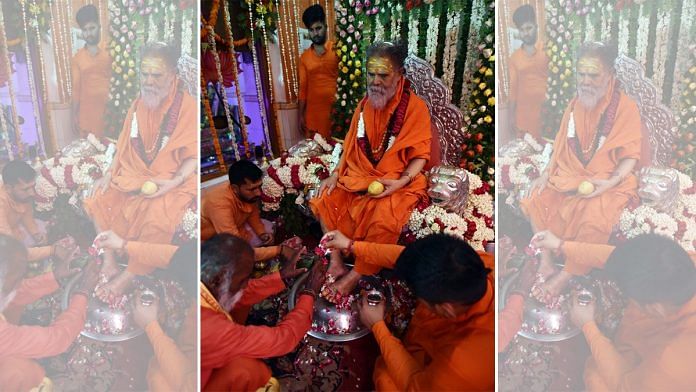New Delhi: Prominent Hindu seer Mahant Narendra Giri’s alleged death by suicide has left many shocked, and put the organisation he headed, the Akhil Bharatiya Akhara Parishad (ABAP), one of the country’s largest groups of Hindu seers, under the spotlight.
Giri’s body was found hanging in his room at Prayagraj’s Baghambari Gaddi Mutt Monday, and condolence messages poured in from across the country, with political leaders such as Prime Minister Narendra Modi, Home Minister Amit Shah, Uttar Pradesh Chief Minister Yogi Adityanath and others expressing their sorrow at his demise.
Giri was also the Mahant of Bade Hanuman Mandir in Prayagraj and the secretary of the Shree Panchayati Akhara Niranjani.
ThePrint explains what is the ABAP, its structure, and Giri’s place at its top.
Also read: The gains of Dismantling Global Hindutva conference will help reclaim Hinduism
What is the ABAP?
The Akhil Bharatiya Akhara Parishad was established in 1954 to organise the Kumbh Mela — the largest religious congregation of Hindus attended by millions — and to settle disputes between the various akharas (or orders of monks). The decision to form an apex body was taken after nearly 800 people died in a stampede in independent India’s first-ever Kumbh Mela in 1954 in Allahabad, as it was then called.
The word ‘akhara’ also means a fighting or wrestling arena, and it is believed, the different monastic orders would clash on who would get the first chance to take the holy dip at the Kumbh Mela.
The akhara culture is believed to have been started by the eighth-century Hindu saint Adi Shankaracharya, who established four Hindu pilgrim spots in the north, south, east and west of the country — Badrinath, Rameshwaram, Puri and Dwarka.
Adi Shankaracharya also believed that Hindu saints and sadhus needed to make themselves physically stronger to take on challenges of foreign invaders, and thus, akharas or wrestling pits were made for the saints to indulge in physical activities, as well as religious debates and discussions.
There were initially four akharas, which over the years were further divided into 13.
The ABAP currently heads all these 13 akharas, which have been divided into three categories depending on their main deity — Shaiva, Vaishnava and Udaseen.
Since the establishment of the ABAP, all Kumbh Melas have been arranged by it. The ABAP includes representatives of all 13 akharas, and takes important decisions regarding the Kumbh Mela, as well as other important decisions related to the monastic orders.
For example, in 2017, it released a list of 14 alleged “fake babas”, which included Gurmeet Ram Rahim Singh of Dera Sacha Sauda, Asaram Bapu and Sant Rampal, among others.
Also read: Aryans or Harappans—Who drove the creation of caste system? DNA holds a clue
Who was Narendra Giri?
Narendra Giri belonged to the Shaivite order of akharas.
Giri (73) was a seer from Prayagraj, who had left home at the age of 22 to become a disciple of seer Divyanand Giri of the Niranjani Akhara of the Shaivites.
It was Divyanand who initiated him into a life of ‘sanyas‘ (renunciation) in 1985 and gave him the name Narendra Giri.
In 2004, Narendra Giri took over as the head of Baghambari Mutt — one of the 13 main akharas in the country, and was first elected president of the ABAP in 2014, for a period of five years. He was re-elected in October 2019.
The Kumbh Mela held earlier this year was also organised under Narendra Giri’s presidentship, but the seer could not participate in the ‘shahi snan‘ (considered especially holy) after testing positive for Covid.
Narendra Giri had also played an important part in the Ram Janmabhoomi movement and was one of the invitees for the Bhoomi Pujan celebration held last year in Ayodhya.
Earlier this year, Narendra Giri allegedly had a fall out with his disciple Anand Giri, over alleged misuse of akhara funds and maintaining ties with his family (which is against the traditions of being a sanyasi). Narendra Giri is believed to have barred Anand Giri’s entry to the Bade Hanuman Mandir because of this.
The deceased seer’s suicide note also mentions Anand Giri — and two others — who have “hurt him”. The police arrested Anand Giri Tuesday.
The wealth of the Baghambari Mutt is also being speculated to be one of the reasons for Narendra Giri’s death. According to reports, the mutt has 80 bigas of farmland in Prayagraj and Kaushambi, an 80-feet wide and 120-feet high gaushala, parcels of land worth crores, as well as schools and ashrams.
(Edited by Poulomi Banerjee)
Also read: We must applaud Thol Thirumavalavan’s stand on Manusmriti. BJP attacking the messenger



